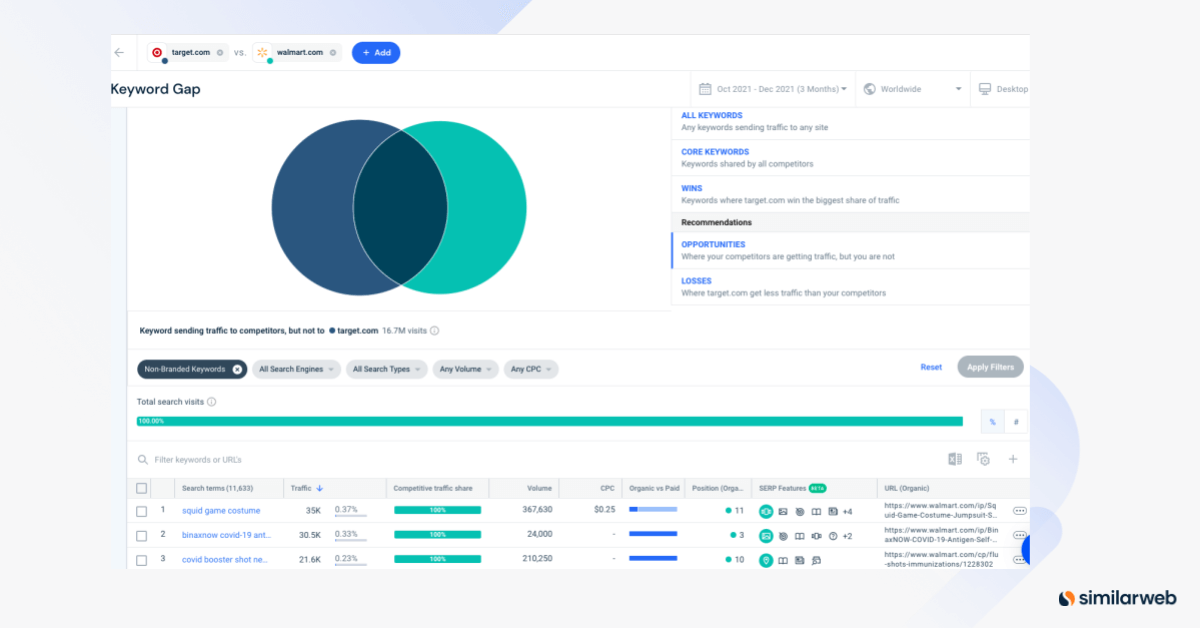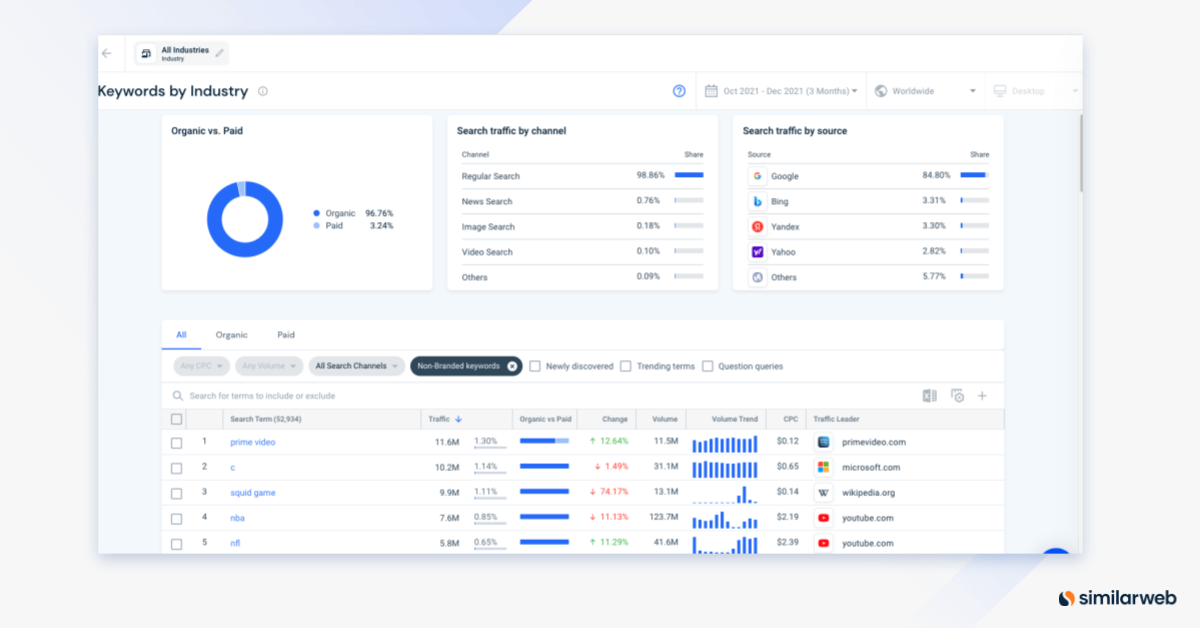 Marketing Intelligence
Marketing Intelligence
B2B Content Marketing: How To Build a Full Strategy In 5 Steps

B2B content marketing is tough.
Not only do you have to explain the ins and outs of tricky, highly technical products, you have to do it in a way that brings technology to life.
On top of that, you have to deal with traditionally long sales cycles – all while competing in a saturated space that’s full of competition, but lacking high-volume, “easy win” keywords.
How do you swerve the pitfalls and start talking about your product in a way that’ll make businesses sit up and take note?
With a B2B content marketing strategy, that’s how.
We’ll let you in on the what and why of B2B content marketing, then hit the how – a comprehensive, five-step guide to building your strategy from the ground up.
We’ve also thrown in several of our top, tried-and-true tactics, as well as a couple of practical examples of brilliant B2B content.
What is B2B content marketing?
Located somewhere between an art and a science, B2B (business-to-business) content marketing is the process of using content to build your brand awareness, develop your audience, and – ultimately – generate leads, sales, and the reputation of your company.
As the name suggests, B2B content marketing is by businesses, to businesses. The content itself can be anything: blogs, articles, eBooks, podcasts, newsletters, infographics, white papers, or social media posts.
Why is content marketing important for B2B companies?
First and foremost, content marketing is vital for B2B companies because it works.
Why else would the most successful B2B marketing teams spend almost half (40%) of their budgets on content? Why else would 77% of B2B agencies send out an email newsletter to keep their audience engaged? And – if content marketing wasn’t crucial to B2B marketers – why do 92% of them believe the pieces of content they produce to be their most priceless marketing assets?
Oh yes – when it comes to generating leads from potential customers and making money, content works.
But unlike other forms of marketing, B2B content plays the long game. It’s not focussed exclusively on using its readers to earn, but on helping them learn – on educating its customers and wider audience with informational, incisive articles and blogs.
B2B content also aims to establish its authors as experts in their field. It can build a company’s brand and engender trust and loyalty, while articulating and addressing the pain points of its readers. And, amidst all this, it can explain the features and benefits of its product – high-quality content formats mean it doesn’t even feel like marketing.
B2B vs. B2C content marketing
So how do B2B content marketing efforts differ from its B2C (business-to-consumer) counterpart? Let’s take a peek.
How to build a B2B content marketing strategy in 5 steps
1. Understand your buyer personas, industry, and competitors
B2B content doesn’t exist in isolation. It’s part of a larger digital marketing strategy.
Whatever articles, blog posts, or eBooks you create will be heading into an already dense, interconnected ecosystem of similar content. So before blazing forward, you’ll want to know exactly what – and who – you’re up against.
In other words, you’ll need to do your research. You need to understand your buyer personas.
Competitors
Who are the key players in your industry and what kind of content are they producing? Which channels – be it organic, paid, or social – are they using to promote their content, and how?
Look at how they’ve approached their own B2B strategies, and take note of both the good bits that you can emulate, as well as the pitfalls you can avoid. Good competitor analysis should also unearth gaps in your rival’s content – and spark ideas as to how you can fill them.
Similarweb is great for this. It allows you to zoom into the digital performance of any company and get more granular insights into their strategies – all via a single, personalized dashboard. Now that’s marketing magic.
Industry
It’s not just your competitors you’ll need to develop a keen understanding of, but the wider industry, too.
Exploring the wide range of companies, influencers, and content that exists in and around your business’s space will help you:
- Identify potential link-building opportunities: you could write a guest post for a well-respected website to boost your B2B site’s SEO and domain authority, or outreach your own research to top sites.
- Find out about industry events and webinars: network with your industry’s top brass, then write about it later to increase your E-A-T (expertise, authoritativeness, and trustworthiness) in the eyes of search engines
- Get to grips with what types of digital learning exist in your industry: you may want to offer your own online course in the future to build up a reputation as an authority.
It’s important to keep an eye not only on the key patterns and players within your industry, but the main content marketing trends of the moment, too. As well as helping you understand what’s hot now, you’ll also get a taste of what’s set to be big going forward – and how to use that knowledge to steal a march on your competition!
Pro tip: Check out Similarweb Industry Level Keywords to see how your SEO keyword strategy impacts your content marketing efforts and SERP ranking.
Audience
Building a clear picture of the kind of people you’re creating your content for will help you ensure it’s tailored to the right readers.
Of course, you’re going to be writing B2B content – so your audience will be businesses. But we’d suggest asking market research questions to look beyond the business, and at the people running it.
Drill down into their demographics; their job titles and functions. How old are they? Which social media platforms do they frequent? What are their go-to sources of information when it comes to finding and researching products?
Create user personas to outline the goals, motivations, pain points, and blockers of your typical reader – they’ll come in handy when it’s time to write your content!
2. Define your strategy’s objectives and KPIs
Now you know what you’re getting into, it’s time to set yourself up for success.
To do that, you’ll first need to clearly outline and articulate your strategy and brand objectives. Is it to drive conversions with targeted, middle-of-the-funnel content, or to play the long game – building up your brand and industry expertise with informational articles and gated assets?
To help ensure your objectives stick, make them SMART:
- Specific
- Measurable
- Achievable
- Relevant
- Time-bound
Of course, no strategy’s “what” is worth its salt without the right “how” in place. So have a think about the tools and techniques you’ll use to execute and monitor your strategy.
How, for instance, will you measure your B2B content’s key metrics? Dig deeper not only into your prospective audience, but where they’re already going to browse B2B content like yours? Benchmark your content’s statistics against the competition?
You’ll also need to develop a strong understanding of the kind of channels you’ll use to publish your content. Since you’re in the B2B sector, organic content – SE-optimized blogs and articles – will most likely be your main focus. But your strategy should also take into account:
- Social media: How will you promote your content to your social media followers and which platforms will you prioritize?
- Email: How will you integrate your organic B2B content into your email strategy and use it to encourage visits to your site?
- Community forums: How can you share – and shout about – your B2B content with a network of engaged, relevant users?
- Relevant CTA’s and landing pages: What’s your call-to-action? Where does relevant content lead? What’s your buyer journey like?
- New content formats: Could you reach your audience through thought leadership pieces? Have you tested video content?
To help hold yourself, your writers, and your content accountable, set some key performance indicators (KPIs) at the outset. These could include ascribing specific goals in terms of:
- Conversions
- Traffic
- Time on page
- Revenue
These KPIs will come in handy when it comes to analyzing and improving your content going forward. We’ll get to that shortly – but first, you’ll need to…
3. Set up a content calendar and write detailed briefs
Good B2B content doesn’t emerge out of the ether. It’s always a product of planning, patience, and a painstaking approach to detail.
Here’s where a content calendar comes in. By mapping out the what, when, and where of your content – the subject, time, date, format, and channel – you’ll have increased control and visibility over your B2B business’s strategy in the long run.
You can create your own (albeit basic) content calendar via a spreadsheet, or with a project management tool like Asana, Trello or monday.com. Alternatively, you can go with a dedicated content management software provider, such as CoSchedule or ClearVoice. These are particularly useful, as they allow you to share your content calendar with other collaborators such as writers, editors, or your fellow project stakeholders.
So how will you fill your content calendar? That’s for you to decide. Fortunately, you don’t have to do it alone. To help you plan out your content, you can utilize platforms like:
- Similarweb, for analyzing real-time market trends to find out what’s taking off.
- The Similarweb Keyword Research Tool, for exploring which relevant search terms and phrases people are typing into Google.
- ResponseSource or Help a Reporter Out, for connecting to industry experts capable of lifting your content with exclusive insights.
And remember, you don’t actually have to write all that content now. Depending on the size and scale of your B2B content strategy, you may choose to outsource some – or all – of it to freelance writers.
That’s why getting the brief right is so important. A good content brief should:
- State the reasons for the content’s production, and its success metrics (if any).
- Establish the stage of the funnel it’s targeting, in addition to the target audience and search intent.
- Convey the word count, deadline, and suggested structure.
- Set out the primary and secondary keywords it needs to target, as well as a summary of the search engine results page (SERP) competition.
- Include a list of recommended internal linking opportunities.
Our top brief-writing tip, though, is in the name – so keep it brief!
Good writers won’t need overlong or excessively detailed briefs, and – if anything – bloated briefs can hamper creativity and flair, especially if they’re too specific or demanding. Get in, be concise in laying out exactly what you need from the content, and get out. Your writer (and your schedule) will thank you for it!
4. Create or commission your content
Finally, the part you’ve been waiting for – actually putting your content together!
You can create it all yourself – but that’s not exactly the most direct route to a scalable strategy. Instead, you could hire a team of in-house writers or outsource the work to a number of freelance content creators.
Rob Binns, Content Marketing Manager at a popular London-based B2B marketing agency, outlines the pros and cons of these different approaches: “Hiring full-time, in-house writers is always your best bet for creating compelling, conversion-led copy. Not only will the content they produce be bankably in line with your B2B outfit’s tone of voice and editorial guidelines, you can also offer them longer-term contracts. This allows you to better plan for the future, scale up your content pipeline, and know your strategy is supported by a bunch of reliable writers. “Opting for freelancers, on the other hand, doesn’t guarantee you this. You may find yourself spending a lot of time sourcing and vetting new creatives – not to mention editing their work, providing feedback, and processing their invoices. In my experience, using freelancers alone comes with much more admin – although it does, on balance, offer more flexibility in the long run.”
“Hiring full-time, in-house writers is always your best bet for creating compelling, conversion-led copy. Tweet thisFor more info about the content creation process, explore our essential 3-phase guide to the topic.
5. Analyze and optimize your B2B content’s performance
If there’s one thing a B2B content strategy shouldn’t be, it’s static. It’s not a tool to be put together, used, and then forgotten about, but something dynamic and dextrous; able to shift with the times and trends.
And the same goes for the content itself. You’ve spent time, effort, and money pushing your articles, emails, and posts live – so why forget about them?
B2B content is never “complete’”– there’s always something you can do to improve it, and there are always going to be certain metrics you’ll need to keep a close eye on. For your web content, these include:
For your email B2B content, these might be open, click-through, or forward rates, as well as the amount of recipients that are unsubscribing, or flagging your emails as spam.
And remember, Similarweb Digital Marketing can help with this. One of our product experts can walk you through a live demo to talk you through all the engagement metrics you need to be monitoring, and how Similarweb’s analytics platform can help you leverage these for B2B content success.
B2B content marketing: 4 quickfire tactics
So, your strategy’s in place – nice work.
But before you make a beeline for the doors to start executing it, be sure to whizz through our top five B2B content marketing tactics, first. As a B2B business ourselves, we can safely say that these all come from years of first-hand experience!
1. Turn your writers into brand ambassadors
Good B2B content marketers have good writers. But the best content marketers have brand ambassadors; writers who live and breathe the brand. Encourage your writers to shout about your brand on their social media – particularly LinkedIn – and share their B2B articles across their personal and professional channels.
Plus, this isn’t just good PR.
This kind of brand advocacy will also do your writers’ profiles a world of good when it comes to Google’s E-E-A-T (experience, expertise, authoritativeness, and trustworthiness) ranking signals. The more ways in which your content’s authors can promote themselves as experts (particularly in a niche B2B subject matter), the better the content they write for you will rank.
2. Create a wealth of diverse gated assets
In the world of B2B content marketing, gated assets are a tale as old as time itself – and for good reason.
Gated assets are “locked” resources that users generally have to exchange their contact details – or pay – to get access to. These could be industry reports, ebooks, white papers, calculators, video guides, or templates for writing or structuring a piece of B2B content.
Gated assets work well for increasing your leads and your email list – provided you get them right. The more original, detailed, well-informed, compelling, and genuinely useful your gated assets are, the more traction they’ll get online.
3. Conduct proprietary research
If there’s one way to hammer home your business’s authority in your industry or niche, it’s doing your research.
Not just any old research, though – proprietary research. These are insights your customers and audience can’t get elsewhere. It’s research that goes the extra mile; that digs deeper, or has a scope that outstrips the competition.
On top of giving your credibility a boost, proprietary research can be turned into downloadable ebooks or white papers – in other words, exactly the kind of gated asset your B2B business needs to be producing to get noticed.
4. Outreach your content for wider exposure
The B2B content space is evolving quickly. So quickly, in fact, that simply producing content isn’t enough anymore.
Nope – to succeed in today’s fast-paced B2B space, you have to actively market your content marketing. We’re talking, of course, about outreach – a type of PR that refers to promoting, sharing, and shouting about your content.
And again, the benefits aren’t limited to PR alone. Getting your content picked up and talked about in big publications will underline your expertise in the eyes of users and search engines alike. If you do it right, content outreach can also result in valuable links back to your site – perhaps even from the most recognized authorities in your industry.
Consider, for instance, that a damning 93% of B2B content receives no inbound links from other sites. If you can produce informative, original, and link-worthy material – and outreach it well – you’ll be getting ahead of the lion’s share of the competition!
B2B content marketing examples
Follow the above five simple steps – and utilize those four top tactics – and you’ll end up with a content marketing strategy capable of going toe to toe with B2B’s best.
But we get that you might still be struggling to envision how your content might look in practice, rather than in principle – so here are two of our favorite B2B content marketing examples on the web to get you inspired.
1. Similarweb’s Digital 100
What is it?
The Similarweb Digital 100 is a list of the calendar year’s top-performing brands. The list breaks down, by category, the internet’s most visited websites with the highest engagement rates.
Why is it an example of good B2B content marketing?
On top of thoughtful, original analysis, the Similarweb Digital 100 contains data that’s genuinely useful for businesses, and that shows off – albeit subtly – the capabilities of Similarweb’s web analytics platform. And, while the top 100 eCommerce companies are free to view, the user also has the ability to access the full report.
Downloading this gated asset treats the users to more granular, exclusive insights, in exchange for their name and business details – and a hot ticket into Similarweb’s ecosystem.
2. Startups 100
What is it?
Similar to the example above, the Startups 100 is a yearly campaign that indexes 100 of the best British businesses. Rankings are calculated based on the strength of each company’s finances and concept and on the disruptiveness of their core ideas.
Why is it an example of good B2B content marketing?
The Startups 100 is an excellent case study as to just how multi-faceted B2B content marketing campaigns can be. Not only does it re-affirm the brand’s reputation as a hub for burgeoning British businesses, the 100 also sends plenty of good PR in Startups’ direction – most prominently from featured companies keen to spread the word of their success on social media:
https://twitter.com/CircuitApp/status/1447597907985768453?cxt=HHwWioC5sZWo85YoAAAA
The Startups 100 doesn’t offer any additional gated assets – the full list is available. However, it ensures the content is still driving those sweet B2B sales by peppering lead generation forms throughout the rankings:
As a fusion of PR, brand building, lead generation, and harnessing its own key point of differentiation, the Startups 100 is B2B content marketing – done well.
Further reading: eCommerce Content Marketing: The Ultimate Guide
FAQs
B2B marketing has a reputation for being serious – and a little boring. Does it have to be?
Absolutely not! B2B content isn’t about being as serious as possible, or about stuffing your copy full of jargon. It’s about putting those technical terms into language that everybody can understand, and writing in a way that helps people get to grips with the ins and outs of your product and industry.
Which B2B marketing channel should I prioritize?
This is completely up to you, although – if the current competition is to be believed – organic channels work best for B2B content marketers. Penning SEO-driven blogs, articles, and ebooks – and getting them to appear high up in Google’s SERPs – is almost always the best way of building a naturally strong brand profile and authority.
In addition, LinkedIn will always be a B2B content marketer’s route to social media success, while a good email marketing strategy is essential. Focus on all of these channels as a first port of call – they’ll help you build your brand and audience, without costing you a dime.
The #1 content marketing tool - get started
Give it a try or talk to our marketing team — don’t worry, it’s free!


















